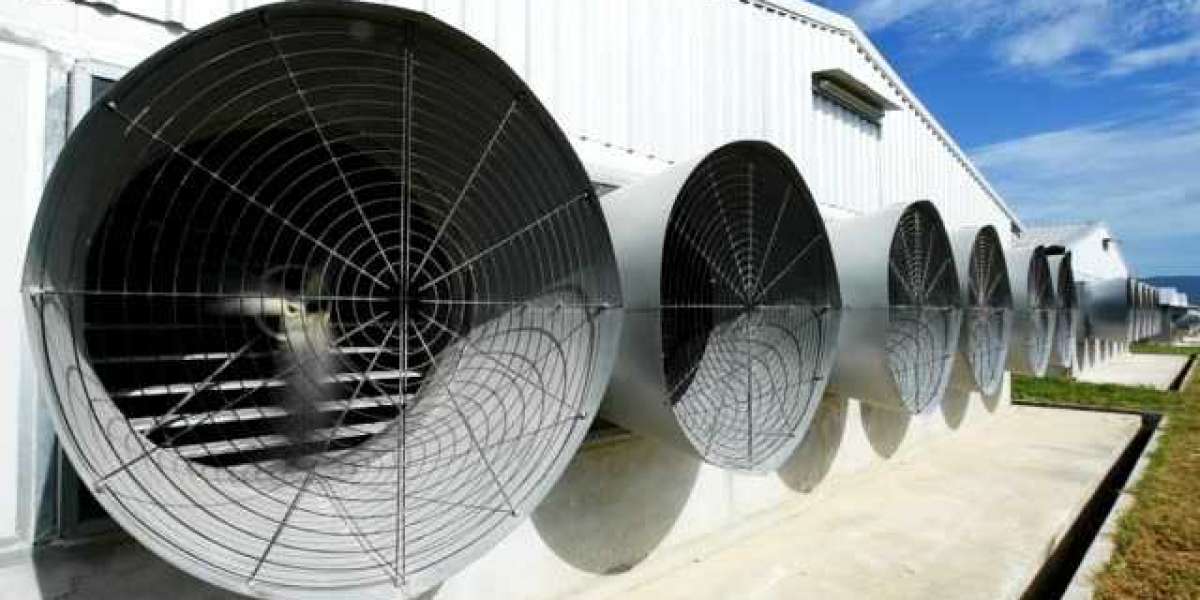Industrial fans play a critical role in maintaining optimal air circulation, temperature regulation, and air quality in large-scale operations such as warehouses, manufacturing plants, agriculture facilities, and commercial spaces. Over the years, these fans have undergone significant technological advancements, resulting in smarter, more energy-efficient systems that provide greater operational benefits while minimizing environmental impact.
As industries continue to prioritize sustainability, energy efficiency, and automation, innovations in industrial fan technology are paving the way for more intelligent and cost-effective solutions. In this article, we’ll explore the latest innovations in industrial fan technology, focusing on smart features, energy-saving solutions, and the role these advancements play in enhancing industrial operations.
1. The Evolution of Industrial Fan Technology
Industrial fans have come a long way since their inception. Early industrial fans were designed primarily for basic air circulation, and their operations were typically quite simple. However, as industrial applications became more complex, the need for more efficient, powerful, and customizable fans grew.
Today’s industrial fans offer much more than basic ventilation. With advancements in motor technology, materials, and control systems, modern industrial fans are capable of delivering precise airflow management, improving energy efficiency, and integrating seamlessly with automated systems. The innovation doesn’t stop at performance improvements — it also includes a growing focus on sustainability, reducing operating costs, and enhancing worker comfort and safety.
2. Smart Features in Industrial Fans
One of the most significant innovations in recent years is the integration of smart technologies into industrial fan systems. These smart features enable real-time monitoring, remote control, and automated adjustments based on environmental conditions, leading to enhanced operational efficiency and improved user experience. Here are some key smart features:
2.1 Smart Controls and Remote Monitoring
Smart industrial fans come equipped with advanced control systems that allow users to monitor and adjust fan performance remotely. These systems often include cloud-based platforms that provide real-time data on the fan’s operation, such as speed, airflow, energy consumption, temperature, and humidity levels. This data can be accessed through a smartphone app, computer dashboard, or even integrated with the facility's building management system (BMS).
With remote monitoring capabilities, operators can quickly identify performance issues, make adjustments as necessary, and ensure that fans are operating at peak efficiency. For example, if a warehouse becomes hotter than expected due to a change in external weather conditions, the fan’s speed can be automatically increased to address the issue without requiring manual intervention.
2.2 Variable Speed Drives (VSD)
Variable Speed Drives (VSD), also known as Variable Frequency Drives (VFD), are becoming standard features in modern industrial fan. These drives allow for continuous adjustment of the fan’s speed based on real-time demand. Unlike traditional fans that operate at fixed speeds, VSD-equipped fans can modulate their speed to match airflow requirements, resulting in substantial energy savings.
VSD technology not only reduces energy consumption but also enhances system longevity. By preventing the fan from running at full speed when it is unnecessary, VSD-equipped fans minimize mechanical wear and tear, leading to fewer maintenance needs and a longer lifespan for the fan.
2.3 Integrated IoT (Internet of Things)
The Internet of Things (IoT) has transformed industrial operations by allowing devices and systems to communicate with each other and share data in real time. Modern industrial fans can now be equipped with IoT sensors that continuously monitor environmental conditions like temperature, humidity, and air quality.
By integrating IoT capabilities, industrial fans can automatically adjust their operations based on environmental changes. For example, if a facility experiences a sudden rise in temperature, the IoT-enabled fan can automatically increase its speed to compensate for the change, optimizing cooling without requiring manual input. Furthermore, IoT integration allows for predictive maintenance by analyzing performance data to predict potential failures, reducing downtime and maintenance costs.
2.4 Condition-Based Monitoring and Predictive Maintenance
In addition to real-time monitoring, smart industrial fans are often equipped with condition-based monitoring systems that track the health of fan components (e.g., motor health, fan blades, bearings). This technology uses data from vibration sensors, temperature sensors, and other diagnostic tools to provide early warnings of mechanical issues before they lead to system failure.
Predictive maintenance algorithms analyze the collected data to predict when a component will require maintenance, allowing facility managers to schedule repairs before they become critical. This proactive approach to maintenance not only reduces the risk of unexpected downtime but also optimizes fan performance and extends the equipment's lifespan.
3. Energy-Saving Solutions in Industrial Fan Technology
Energy consumption is a key concern for industries that rely on large-scale ventilation systems, as traditional cooling and ventilation methods can be energy-intensive. Fortunately, many recent innovations in industrial fan technology focus on improving energy efficiency. Here are some of the most effective energy-saving solutions:
3.1 High-Volume Low-Speed (HVLS) Fans
HVLS fans have become popular in large facilities because of their ability to move a large volume of air at low speeds, creating a gentle breeze that circulates throughout the entire space. Unlike traditional fans that focus on small areas and generate powerful, localized airflow, HVLS fans cover vast areas and distribute air more evenly.
By operating at slower speeds, HVLS fans consume less energy while providing the same or even greater cooling effects compared to conventional high-speed fans. Additionally, HVLS fans are known to improve the efficiency of heating systems during colder months by redistributing warm air that accumulates near the ceiling, reducing the need for supplemental heating.
3.2 Energy-Efficient Motors
Modern industrial fans are equipped with energy-efficient motors that use less power while delivering the same or higher airflow than traditional motors. These motors typically have higher efficiency ratings, which means they convert more electrical energy into mechanical power, reducing wasted energy in the process.
In many cases, energy-efficient motors can reduce energy consumption by up to 30% compared to older, less efficient motors. When combined with other energy-saving features such as VSDs and IoT integration, these motors contribute significantly to lowering the overall energy usage of industrial fan systems.
3.3 Fan Blade Design and Aerodynamics
Another innovation that contributes to energy efficiency is improved fan blade design. Modern fan blades are designed using advanced aerodynamic principles to reduce drag, optimize airflow, and minimize the energy required to move air. These designs ensure that industrial fans can provide maximum airflow with minimal energy consumption.
By using lightweight yet durable materials such as carbon fiber or advanced polymers, manufacturers have also been able to reduce the weight of the fan blades, further improving efficiency and reducing wear on motor components. In some cases, the angle of the fan blades can be adjusted to enhance airflow dynamics, allowing the fan to run more efficiently in various conditions.
3.4 Smart Integration with Building Management Systems (BMS)
Another significant advancement in energy savings comes from the integration of industrial fans with a building’s Building Management System (BMS). A BMS controls and monitors various building systems such as heating, ventilation, lighting, and air conditioning (HVAC). When connected to a BMS, industrial fans can work in coordination with other environmental control systems to optimize energy consumption.
For example, if the BMS detects that certain sections of the facility are unoccupied, it can automatically reduce the fan speed or turn off the fans entirely in those areas. Similarly, if the BMS detects a temperature rise in a specific section, it can trigger the fans to increase airflow, ensuring the facility remains within desired temperature ranges without unnecessary energy expenditure.
3.5 Demand-Responsive Ventilation
Some industrial fans now come equipped with demand-responsive ventilation capabilities, which adjust fan speed based on real-time requirements. For instance, if a manufacturing facility experiences a sudden spike in production and the air quality deteriorates as a result, the fan system can automatically increase airflow to maintain optimal air quality and temperature. Conversely, during periods of low activity, the fans can operate at a lower speed or be turned off to save energy.
Demand-responsive systems are particularly valuable in large-scale facilities where environmental conditions fluctuate throughout the day. By dynamically adjusting ventilation needs, industrial fans can provide significant energy savings while maintaining a healthy and comfortable environment for workers.
4. The Future of Industrial Fans
The future of industrial fan technology looks promising, with continued advancements expected in both efficiency and intelligence. As sustainability becomes an even more pressing issue across industries, further improvements in energy efficiency, integration with renewable energy sources, and advancements in smart technology will likely drive the development of even more advanced fan systems.
For example, the use of solar-powered industrial fans may become more widespread, helping facilities reduce their reliance on grid electricity. Additionally, the integration of artificial intelligence (AI) and machine learning could further enhance predictive maintenance, energy management, and operational optimization.
Conclusion
Innovations in industrial fan technology, from smart controls to energy-saving solutions, are transforming the way large-scale operations manage airflow, ventilation, and climate control. By embracing these advancements, industries can improve operational efficiency, reduce energy consumption, and create more comfortable, productive environments for workers.






